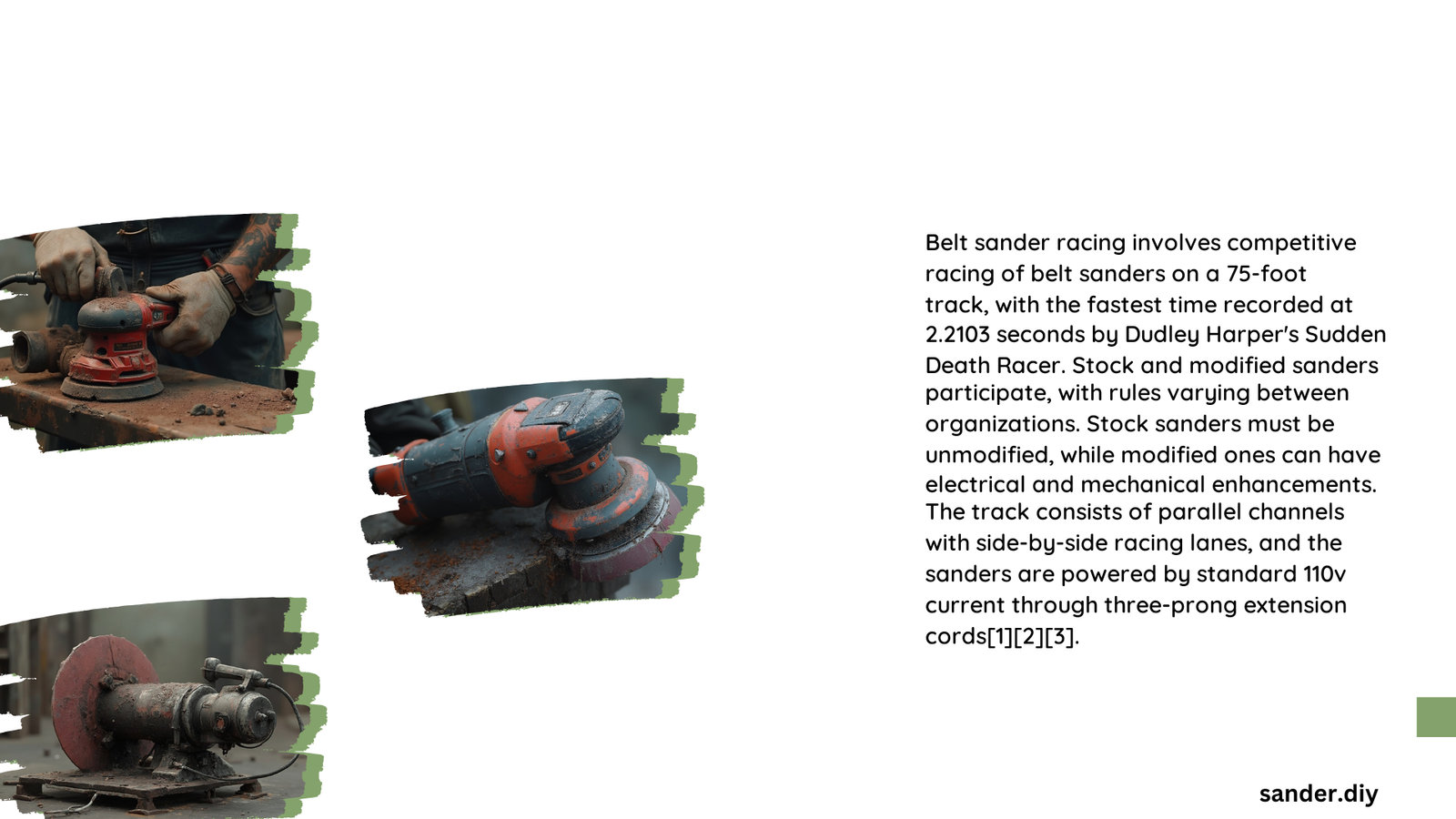Belt sander racers are modified power tools used in unconventional drag racing events. These machines, typically based on standard belt sanders, are transformed into high-speed racers that compete on specially designed tracks. Enthusiasts modify their sanders for maximum speed and performance, creating a unique blend of DIY engineering and competitive racing.
What is a Belt Sander Racer?
A belt sander racer is a modified belt sander used for competitive racing. These machines are adapted from standard power tools to achieve higher speeds and better performance on straight tracks. Racers compete in various classes, including stock and modified categories, showcasing their engineering skills and racing prowess.
What are the Key Specifications of a Belt Sander Racer?

Belt sander racers come in various configurations, but here are some typical specifications:
- Motor Power: 10-15 amps
- Belt Size: 3-4 inches wide, 18-24 inches long
- Top Speed: Up to 1650 feet per minute (for Makita 9403)
- Weight: 10-15 pounds
These specifications can vary depending on the model and modifications made by racers.
How Do Belt Sander Racers Perform?
Performance of belt sander racers depends on several factors:
- Motor power and efficiency
- Belt quality and traction
- Weight distribution
- Modifications and tuning
Top-performing racers like the Makita 9403 are known for their high speed and reliability in stock class races.
What are the Most Effective Racing Techniques?
To excel in belt sander racing, consider these techniques:
- Smooth Start: Ensure proper alignment and secure positioning at the start line.
- Straight Line Stability: Use track guides and wheelie bars to maintain course.
- Maintenance: Regular upkeep to prevent slippage and ensure smooth operation.
- Weight Distribution: Balance the sander for optimal performance.
How Can You Modify a Belt Sander for Racing?
Modifications can significantly enhance performance:
| Modification | Purpose | Estimated Cost |
|---|---|---|
| High-quality belts | Improved traction | $20-$50 |
| Motor upgrades | Increased speed | $50-$200+ |
| Track guides | Better stability | $30-$70 |
| Wheelie bars | Improved control | $20-$50 |
Additionally, consider these enhancements:
– Dry lubricants for reduced friction
– Polished axles for smoother operation
– Upgraded drive systems for better power transfer
What are the Rules and Regulations for Belt Sander Racing?
Belt sander racing rules can vary by event, but common regulations include:
- Stock class restrictions on modifications
- Safety requirements (e.g., kill switches)
- Track specifications (typically 75 feet long)
- Start and finish line procedures
Always check with the specific event organizers for detailed rules.
How Fast Can a Belt Sander Racer Go?
The speed of a belt sander racer depends on various factors:
- Stock sanders like the Makita 9403 can reach 1650 feet per minute
- Modified racers may achieve higher speeds
- A 75-foot track could theoretically be covered in about 2.2 seconds at top speed
Actual race times may vary due to acceleration and track conditions.
What are the Safety Considerations for Belt Sander Racing?
Safety is paramount in belt sander racing:
- Use proper protective gear (eye protection, gloves)
- Ensure all modifications are secure
- Install and test kill switches
- Follow all event safety guidelines
- Be aware of potential motor overheating
How Do You Maintain a Belt Sander Racer?
Proper maintenance is crucial for performance and longevity:
- Clean the sander after each race
- Check and replace belts regularly
- Lubricate moving parts with dry lubricants
- Inspect electrical components for wear
- Store in a dry, clean environment
What is the History of Belt Sander Racing?
Belt sander racing originated as a quirky DIY sport, combining the thrill of racing with the ingenuity of tool modification. While the exact origins are unclear, it has grown into a popular event at maker fairs and community gatherings, showcasing creativity and engineering skills.
Where Can You Participate in Belt Sander Racing Events?
Belt sander racing events are often held at:
- Maker fairs and DIY conventions
- Community festivals
- Hardware store promotions
- Woodworking club meetings
Check local event listings or online forums for upcoming races in your area.
What are the Future Trends in Belt Sander Racing?
The future of belt sander racing may include:
- More advanced motor and battery technologies
- Integration of IoT for performance tracking
- Expansion of racing categories (e.g., obstacle courses)
- Increased focus on eco-friendly modifications
As the sport evolves, expect to see more innovative designs and competitive events.
Belt sander racing combines the thrill of speed with the satisfaction of DIY engineering. Whether you’re a seasoned woodworker or a racing enthusiast, this unique sport offers a fun and challenging way to push the limits of everyday power tools.
References:
1. Build a WINNING Belt Sander Drag Racer : 14 Steps
2. Belt Sander Racing – Yea…It’s a Real Thing
3. Rules – Belt Sander Drag Races
